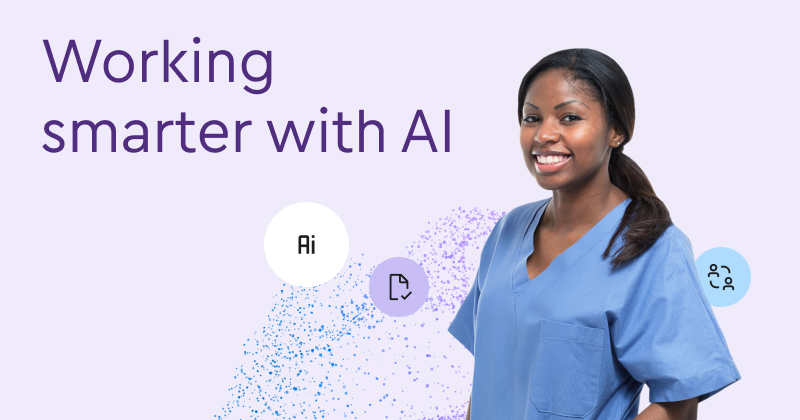3 Ways to Help Enhance Operational Efficiency With AI

Explore how AI could help streamline workflows and help your practice staff develop personal relationships that can’t be automated
In many bustling medical practices, front desk staff are overwhelmed by constant phone calls, patients spend too much time on hold, faxed referrals go unanswered and billers struggle to appeal denied claims.
However, as the industry increasingly integrates artificial intelligence (AI), valuable solutions are being developed to help you overcome these hurdles. Bonus? Patients are aligned with their adoption. One study found that over half of patients surveyed think using AI for administrative tasks is a “good or great idea” for healthcare providers.1
Find out how a new wave of AI solutions could help reduce the burden on your practice’s staff so they can focus on more critical person-to-person connections.
1. Smarter faxing with AI
Imagine a busy practice where the staff is constantly playing catch-up with faxed treatment plan authorizations. Their fax management process requires significant manual effort from the staff and can involve up to 20 human touchpoints per fax.
Suppose a noticeable drop in referrals, caused by long lag times to authorize faxed treatment plans, motivated the practice to implement an AI-powered faxing sorting tool. This tool could efficiently analyze incoming faxes, identify patient information, and suggest patients to link to incoming faxes.
With this solution in place, the number of human touchpoints per fax could drop to four or five, allowing the practice to respond to treatment plans promptly. The practice might improve operational efficiency, establish stronger relationships with referring providers and significantly increase patient volume.
“After implementing Enhanced Faxing, we can process and share results promptly, which enhances patient care. This efficiency cuts down my processing time from one minute to just 10 seconds.”
James Bienvenu, MD
Knoxville, TN
2. AI-assisted claims denial assessment
Suppose a busy practice’s billing team spent countless hours processing rejected claims and resubmitting them to payers. An AI-assisted claims denial assessment tool designed to identify claims with a higher likelihood of denial before submission, based on historical data, could be transformative.
Did you know?
Research shows that 57% of healthcare providers have reported reduced administrative burdens by introducing AI and automation.1
Instead of repeatedly resubmitting denied claims, the billing team could resolve flagged issues before submission and help ensure timely payments from insurance companies. With the significant time savings freed up by AI-powered denial management, the billing team could, for example, engage patients struggling to meet their financial obligations. They might initiate conversations and negotiate personalized payment plans that would be mutually advantageous.
The affected patients are likely to feel valued because the practice supported them during challenging times. This approach could not only increase patient loyalty but could also lead to improved retention rates, as patients might opt to remain with a practice that demonstrates compassion and care in the exam room and in the billing office.
3. AI-assisted patient message routing
Consider a patient who is worried about their recent test results and sends a detailed question through the online patient portal; an AI message routing tool could auto-route their query to a clinician on the team. A timely response could help reassure the patient, making them feel acknowledged and supported, showcasing how technology can help strengthen patient-provider relationships.
Conversely, a pressing message could easily get lost in a crowded inbox without an AI message routing solution. Consider a scenario where a patient shares concerns regarding potential medication side effects in the portal, only to have their message overlooked for several hours as staff members manually sort through incoming messages in the order they arrive. When the patient follows up with a phone call, the staff member who answers may not have read the original message. They might relay the patient’s concerns but may struggle to convey the urgency.
By the time the nurse practitioner returns the call, the patient’s anxiety may have escalated, and the lack of context could hinder the provider’s ability to address specific fears.
Without AI-assisted message routing, miscommunication and delays erode trust, preventing staff from forming the critical connections that foster patient satisfaction. As a result, a patient may feel more anxious and may even consider seeking care elsewhere.
These two contrasting situations illustrate the importance of integrating technology with personalized care to elevate patient engagement and help them feel valued. Often, the smallest gestures — like a friendly smile or good eye contact from the front desk — can make all the difference in a patient’s perceived experience and retention.
Did you know?
One study found that recruiting a new customer can cost five times more than keeping an existing one.2
Conclusion
While AI technology can significantly improve efficiency in medical practices, it is essential to remember that the goal is to free up healthcare providers to focus on the human empathy, creativity and insight that AI can’t replicate. By leveraging these advancements, you can redefine your culture of care, creating a human-centered system where real patients feel seen and heard by real providers.
Ready to transform your practice with AI? Book a demo to explore how AI could work for you.
1 Google. “Measuring the administrative burden on U.S. healthcare workers — and how generative AI can help.” Google Cloud. 2024.
2 Morgan, B. “Does It Still Cost 5x More to Create a New Customer Than Retain an Old One?” Forbes.com. April 2019.
This blog is intended for informational purposes only and does not constitute legal or medical advice. Please consult with your legal counsel and other qualified advisors to ensure compliance with applicable laws, regulations, and standards.







